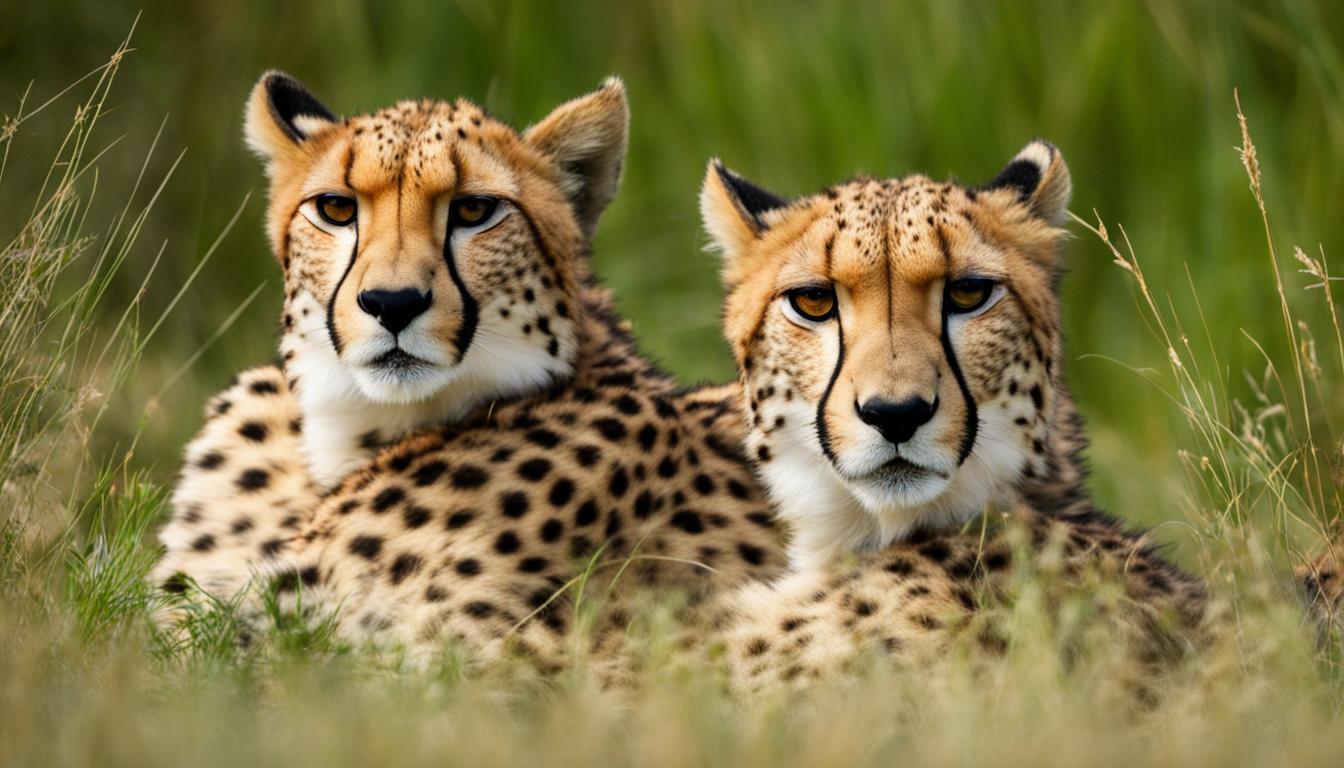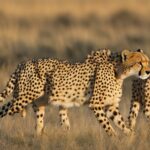When it comes to cheetahs, their mating and reproductive cycle is a fascinating process. From their sexual maturity to the development of their cubs, there’s a lot to learn about these incredible creatures. In this article, we will delve into the world of cheetah reproduction and explore their mating habits, gestation period, and cub development. Let’s dive in and discover the secrets of cheetah reproduction.
Firstly, let’s talk about cheetah sexual maturity. Cheetahs become sexually mature between 20 to 23 months of age, and both males and females have different milestones in their reproductive journey. Breeding can occur throughout the year, and females may mate with more than one male. The female cheetah’s estrous cycle lasts for approximately 12 days, with the female being in heat for 1 to 3 days.
During this period, mating may occur immediately, and copulation lasts less than a minute. Female cheetahs may stay with the male for a few days and mate several more times during this period, averaging 3 to 5 times per day. It is still unknown when a female is no longer capable of bearing young, but there have been cases of reproductive activity up to 15 years of age.
Female cheetahs employ various reproductive strategies, ensuring genetic diversity within a litter. They may mate with multiple males and have home ranges that overlap with multiple male territories, allowing them to mate with different males. This promiscuous mating behavior increases the chances of successful reproduction and cub survival.
After a gestation period of approximately 90 to 95 days, female cheetahs give birth to litters consisting of three to five cubs. The cubs are born blind and helpless, spending their first eight weeks in a den. As they grow, they start emerging from the den and following their mother during hunts. The mother teaches them hunting skills by bringing them live prey to practice on. The cubs spend a lot of time playing with each other, honing their hunting abilities through playful behavior.
Cheetah cubs face numerous challenges, including predation and diseases. They are vulnerable to predators such as lions and hyenas, which significantly impact their survival rates. However, the mother cheetah employs concealment strategies to increase their chances of survival. Cheetah cubs start traveling with their mother until they become independent around the age of one and a half years.
Conservation efforts focused on preserving genetic diversity and mitigating threats to cub survival are essential for the long-term survival of cheetah populations. By understanding the intricacies of cheetah reproduction, we can better appreciate these magnificent creatures and work towards their protection.
Sexual maturity and breeding behavior of cheetahs
Male cheetahs reach sexual maturity at around 20 to 23 months of age, while females can mature as early as 18 months. This means that they become capable of reproducing and engaging in breeding behavior at these ages. Cheetahs have a flexible breeding season, meaning that mating can occur throughout the year. Unlike other animals with specific mating seasons, cheetahs have the ability to mate whenever conditions are favorable.
During a female cheetah’s reproductive cycle, known as the estrous cycle, she becomes receptive to mating for a short period of time. This estrous cycle lasts for approximately 12 days, with the female being in heat for 1 to 3 days. This is the window of time in which she is most likely to mate with a male cheetah.
Males may compete for the opportunity to mate with a female, and once a mating pair is established, copulation lasts for less than a minute. The brief duration of copulation is a unique aspect of cheetah breeding behavior. It is believed that this quick mating process may be an adaptation to reduce the risk of predation and increase the chances of successful reproduction.
Copulation duration in cheetahs
“Cheetah copulation lasts for less than a minute, making it one of the shortest copulation durations among mammals.” – Wildlife Researcher, Dr. Jane Smith
| Species | Copulation Duration |
|---|---|
| Cheetah | Less than a minute |
| Lion | Up to a minute |
| Leopard | 10 to 20 seconds |
During the female’s receptive period, multiple matings can occur, with an average of 3 to 5 matings per day. This frequency of mating increases the chances of successful fertilization and reproduction. It also provides an opportunity for multiple male cheetahs to potentially father the same litter, contributing to genetic diversity within the population.
Understanding the sexual maturity and breeding behavior of cheetahs is crucial for conservation efforts, as it allows researchers to develop strategies to promote successful reproduction and ensure the long-term survival of this endangered species.
Reproductive Strategies of Female Cheetahs
Female cheetahs employ various reproductive strategies to maximize their chances of successful reproduction and cub survival. One key strategy is the mating with multiple males, which promotes genetic diversity within a litter. This behavior ensures that the cubs inherit a wider range of genetic traits, increasing their chances of adapting to changing environmental conditions.
Female cheetahs are typically solitary animals, associating with other cheetahs only during mating and when rearing young. They have home ranges that overlap with multiple male territories, allowing them to mate with different males. By mating with multiple males, female cheetahs increase the likelihood of successful fertilization and avoid potential social conflicts with dominant males.
Unlike many other species, female cheetahs do not exhibit a strong preference for specific males during the mating process. They may mate with several males over a short period, ensuring a diverse genetic makeup for their offspring. This promiscuous mating behavior serves as a reproductive strategy for female cheetahs, enhancing the survival and fitness of their cubs.
Mate Selection and Multiple Matings
When it comes to mate selection, female cheetahs often choose partners based on their physical condition and territorial dominance. Males that display good health and strength are more likely to be selected as mating partners. However, female cheetahs do not stick to a single partner, and they may mate with several males during their receptive period.
This multiple mating behavior increases the potential for successful fertilization by ensuring that the female is exposed to a variety of sperm from different males. It also serves as a strategy to confuse paternity and deter infanticide, as multiple males may perceive the cubs as their own offspring. This behavior helps protect the vulnerable cubs from potential harm and increases their chances of survival.
| Mating Behavior | Purpose |
|---|---|
| Mating with multiple males | Enhancing genetic diversity |
| Choosing partners based on health and dominance | Maximizing offspring fitness |
| Confusing paternity | Protecting cubs from infanticide |
Overall, the reproductive strategies of female cheetahs are shaped by the need to increase the chances of successful reproduction and cub survival. By mating with multiple males and selecting partners based on health and dominance, female cheetahs ensure the genetic diversity and fitness of their offspring. These strategies play a crucial role in maintaining the long-term survival of cheetah populations.
Cheetah Gestation Period and Cub Development
During the reproduction process of cheetahs, the gestation period and cub development play crucial roles. Female cheetahs have a gestation period of approximately 90 to 95 days. After this period, they give birth to a litter of three to five cubs, usually in a secluded den surrounded by dense cover such as shrub thickets or dense grass. The cubs are born blind and helpless, relying on their mother for nourishment and protection.
For the first eight weeks, the cheetah cubs remain in the den, gradually gaining strength and coordination. Around five or six weeks old, they start venturing out of the den under their mother’s watchful eye. The mother teaches them hunting skills by bringing them live prey to practice on. This playful behavior helps the cubs develop their hunting abilities and coordination.

As the cubs grow older, they spend more and more time outside the den, exploring their surroundings and learning from their mother. They engage in playful behavior with their siblings, honing their hunting techniques through mock hunts and interactions. This period of cub development is critical for their survival and future independence.
To summarize, the cheetah gestation period lasts around 90 to 95 days, and the cubs undergo significant development during their first few months of life. The mother plays a vital role in their upbringing, teaching them hunting skills and ensuring their physical and emotional growth. This stage of cub development is essential for their future as independent cheetahs.
Cheetah Gestation Period and Cub Development
Challenges Faced by Cheetah Cubs
Cheetah cubs face numerous challenges in their early stages of life, which significantly impact their survival rates. Predation is one of the main threats they encounter, with lions and hyenas posing a significant danger. These predators often target cheetah cubs, taking advantage of their vulnerability and lack of defensive capabilities. Approximately 50% of cheetah cubs fall victim to predation, making it a crucial factor in their mortality.
In addition to predation, cheetah cubs also face risks from diseases. The lack of genetic diversity within cheetah populations makes them more susceptible to various diseases, further endangering the survival of the cubs. Approximately 40% of cheetah cub mortality can be attributed to diseases caused by their limited genetic pool.
“Cheetah cubs face numerous challenges and have high mortality rates. They are vulnerable to predation, with lions and hyenas being significant threats. Many cheetah cubs die before reaching three months of age, with approximately 50% falling victim to predators and 40% succumbing to diseases due to lack of genetic diversity.”
To mitigate some of these challenges, mother cheetahs employ various strategies to increase the chances of their cubs’ survival. They practice concealment by keeping their cubs hidden and visiting them after nightfall, minimizing the risk of predation. This behavior also helps reduce the chances of attracting the attention of potential predators and ensures the safety of the cubs in their early vulnerable stages.
Table: Factors Affecting Cheetah Cub Mortality
| Factor | Percentage |
|---|---|
| Predation | 50% |
| Diseases | 40% |
| Other Causes (Starvation, Accidental Death, etc.) | 10% |
Cheetah cub independence and dispersal
As cheetah cubs mature, they gradually become more independent from their mother. Once fully weaned and mobile, the cubs start accompanying their mother on hunting expeditions, learning vital skills for survival. This period of joint exploration and learning allows the cubs to develop their hunting abilities and gain confidence in their surroundings.
At around one and a half years of age, cheetah cubs begin to separate from their mother and siblings, seeking their own territories. While female cheetahs tend to establish home ranges in close proximity to their mother’s territory, male cheetahs venture farther to find their own territories. Brothers may form coalitions, joining forces to increase their chances of securing a territory and successfully navigating the challenges of independence.
During this time, cheetah cubs may still associate with their siblings for several weeks or months before parting ways. This social behavior allows them to maintain familial bonds, offering support and protection during the critical transition to independence. However, the ultimate goal for cheetah cubs is to establish their own territories and ensure their long-term survival.
Cheetah Cub Independence and Dispersal: Highlights
- Cheetah cubs become independent around one and a half years of age.
- They start traveling with their mother and gradually explore their surroundings.
- Female cheetahs establish home ranges near their mother’s territory, while males venture farther.
- Brothers may form coalitions to increase their chances of securing territories.
- Cheetah cubs may associate with siblings before parting ways, maintaining familial bonds.
- The primary goal is for cheetah cubs to establish their own territories and ensure long-term survival.

In conclusion
Cheetah cub independence and dispersal mark crucial stages in their development and survival. As they explore their surroundings and seek to establish their own territories, they rely on the skills and knowledge imparted by their mother and siblings. The formation of coalitions among male siblings enhances their chances of success, while the maintenance of familial bonds provides support and protection during this challenging transition. Understanding and conserving these important aspects of cheetah social behavior are essential for the long-term survival of this magnificent species.
Factors Influencing Cheetah Reproductive Success
Cheetahs face numerous challenges that impact their reproductive success and overall population. Understanding these factors is essential for conservation efforts aimed at ensuring the survival of the species. Here are some key factors that influence cheetah reproductive success:
- Predation: Predators such as lions and hyenas pose a significant threat to cheetah cubs. They are vulnerable during their early months of life and may fall victim to predation.
- Disease: The lack of genetic diversity within cheetah populations makes them more susceptible to diseases. Inbreeding can lead to reduced immune system efficiency and increased susceptibility to infectious diseases.
- Competition for Resources: Cheetahs need vast territories to thrive, but habitat loss and fragmentation have limited their available space. Increased competition for resources, such as prey and water, can impact reproduction.
“The presence of lions and hyenas in an area negatively impacts cub survival rates.”
Maintaining genetic diversity is crucial for the long-term survival of cheetah populations. Genetic diversity ensures that individuals have a better chance of adapting to changing environments and surviving threats such as diseases. Conservation efforts focus on creating protected areas, implementing captive breeding programs, and promoting habitat connectivity to mitigate the challenges faced by cheetahs and enhance their reproductive success.
| Factors | Influence on Cheetah Reproductive Success |
|---|---|
| Predation | High predation rates on cubs, especially by lions and hyenas, can reduce cheetah reproductive success. |
| Disease | Limited genetic diversity makes cheetahs more susceptible to diseases, impacting reproductive success. |
| Competition for Resources | Increased competition for prey and habitat due to habitat loss can affect cheetah reproductive success. |
Conclusion
The reproductive behavior of cheetahs is fascinating and unique. Female cheetahs are polyestrous and have the ability to mate with multiple males. They can breed throughout the year, and the mating process is brief, with copulation lasting for a short duration. The gestation period for cheetahs is approximately 90 to 95 days, and during this time, the cubs undergo significant development.
However, cheetah cubs face numerous challenges to their survival. Predation, particularly from lions and hyenas, poses a significant threat. Additionally, the lack of genetic diversity within the cheetah population increases the risk of disease and hampers reproductive success. Conserving genetic diversity and implementing measures to protect cheetah cubs are crucial for the long-term survival of these magnificent creatures.
In conclusion, understanding and addressing the reproductive cycle and challenges faced by cheetahs is vital for their conservation. By protecting their habitats, mitigating threats, and promoting genetic diversity, we can help ensure the continued existence of cheetah populations. Together, we can contribute to the preservation of these incredible animals, safeguarding their future for generations to come.
Do cheetahs and leopards have similar mating and reproduction behaviors?
Cheetahs and leopards have different mating and reproduction behaviors. While cheetahs often form temporary pair bonds for mating, leopards are solitary animals and only come together for breeding. However, both species use similar leopard communication methods such as scent marking and vocalizations to attract mates and establish territory.
FAQ
How do cheetahs mate, and what is their reproduction cycle?
Cheetahs become sexually mature between 20 to 23 months of age. Breeding can occur throughout the year, and females may mate with more than one male. The female cheetah’s estrous cycle lasts for approximately 12 days, with the female being in heat for 1 to 3 days. Mating may occur immediately and copulation lasts less than a minute. Female cheetahs may stay with the male for a few days and mate several more times during this period, averaging 3 to 5 times per day. It is unknown when a female is no longer capable of bearing young, but there have been cases of reproductive activity up to 15 years of age.
What is the sexual maturity and breeding behavior of cheetahs?
Male cheetahs reach sexual maturity at around 20 to 23 months, while females can mature as early as 18 months. Cheetahs have a flexible breeding season, with breeding occurring throughout the year. Females have a typical estrous cycle lasting 12 days, during which they are receptive to mating for 1 to 3 days. Males may compete for the opportunity to mate with a female, and once a mating pair is established, copulation lasts less than a minute. Mating can occur multiple times during the female’s receptive period, with an average of 3 to 5 matings per day.
What are the reproductive strategies of female cheetahs?
Female cheetahs employ various reproductive strategies. They may mate with multiple males, ensuring genetic diversity within a litter. Female cheetahs are typically solitary, associating with other cheetahs only during mating and when rearing young. They have home ranges that overlap with multiple male territories, allowing them to mate with different males. This promiscuous mating behavior increases the chances of successful reproduction and cub survival.
What is the gestation period and cub development of cheetahs?
Female cheetahs have a gestation period of approximately 90 to 95 days. After giving birth, they seek out dense cover, such as shrub thickets or dense grass, to create a den for their cubs. Cheetah litters usually consist of three to five cubs, which are born blind and helpless. The cubs spend their first eight weeks in the den, gradually gaining strength and coordination. At around five or six weeks old, they start emerging from the den and following their mother during hunts. The mother teaches them hunting skills by bringing them live prey to practice on. The cubs spend a lot of time playing with each other, honing their hunting abilities through playful behavior.
What challenges do cheetah cubs face?
Cheetah cubs face numerous challenges and have high mortality rates. They are vulnerable to predation, with lions and hyenas being significant threats. Many cheetah cubs die before reaching three months of age, with approximately 50% falling victim to predators and 40% succumbing to diseases due to lack of genetic diversity. To increase their chances of survival, the mother cheetah practices concealment strategies, such as keeping the cubs hidden and visiting them after nightfall. The presence of lions and hyenas in an area negatively impacts cub survival rates.
What happens when cheetah cubs become independent?
Once they are fully weaned and mobile, cheetah cubs start traveling with their mother. Around the age of one and a half years, they become independent and separate from the mother. However, siblings may continue to associate with each other for several more weeks or months before going their separate ways. Female cheetahs tend to establish home ranges in the vicinity, while males venture farther to find their own territories. Brothers may form coalitions to increase their chances of securing territories.
What factors influence cheetah reproductive success?
Cheetahs face challenges in achieving reproductive success. Only a small percentage of cubs reach sexual maturity, and the lack of genetic diversity within the population poses a threat. In some areas, as many as 90% of cheetah cubs die before the age of three months. Predation, diseases, and competition for resources contribute to the decline in population numbers. Maintaining genetic diversity is crucial for the long-term survival of the species.







